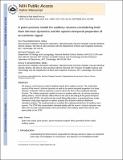| dc.contributor.author | Plourde, Eric | |
| dc.contributor.author | Delgutte, Bertrand | |
| dc.contributor.author | Brown, Emery N. | |
| dc.date.accessioned | 2014-05-01T13:07:50Z | |
| dc.date.available | 2014-05-01T13:07:50Z | |
| dc.date.issued | 2011-02 | |
| dc.identifier.issn | 0018-9294 | |
| dc.identifier.issn | 1558-2531 | |
| dc.identifier.uri | http://hdl.handle.net/1721.1/86313 | |
| dc.description.abstract | We propose a point process model of spiking activity from auditory neurons. The model takes account of the neuron's intrinsic dynamics as well as the spectrotemporal properties of an input stimulus. A discrete Volterra expansion is used to derive the form of the conditional intensity function. The Volterra expansion models the neuron's baseline spike rate, its intrinsic dynamics-spiking history-and the stimulus effect which in this case is the analog of the spectrotemporal receptive field (STRF). We performed the model fitting efficiently in a generalized linear model framework using ridge regression to address properly this ill-posed maximum likelihood estimation problem. The model provides an excellent fit to spiking activity from 55 auditory nerve neurons. The STRF-like representation estimated jointly with the neuron's intrinsic dynamics may offer more accurate characterizations of neural activity in the auditory system than current ones based solely on the STRF. | en_US |
| dc.language.iso | en_US | |
| dc.publisher | Institute of Electrical and Electronics Engineers (IEEE) | en_US |
| dc.relation.isversionof | http://dx.doi.org/10.1109/tbme.2011.2113349 | en_US |
| dc.rights | Creative Commons Attribution-Noncommercial-Share Alike | en_US |
| dc.rights.uri | http://creativecommons.org/licenses/by-nc-sa/4.0/ | en_US |
| dc.source | PMC | en_US |
| dc.title | A Point Process Model for Auditory Neurons Considering Both Their Intrinsic Dynamics and the Spectrotemporal Properties of an Extrinsic Signal | en_US |
| dc.type | Article | en_US |
| dc.identifier.citation | Plourde, Eric, Bertrand Delgutte, and Emery N Brown. “A Point Process Model for Auditory Neurons Considering Both Their Intrinsic Dynamics and the Spectrotemporal Properties of an Extrinsic Signal.” IEEE Trans. Biomed. Eng. 58, no. 6 (n.d.): 1507–1510. | en_US |
| dc.contributor.department | Harvard University--MIT Division of Health Sciences and Technology | en_US |
| dc.contributor.department | Massachusetts Institute of Technology. Department of Brain and Cognitive Sciences | en_US |
| dc.contributor.department | Massachusetts Institute of Technology. Research Laboratory of Electronics | en_US |
| dc.contributor.mitauthor | Plourde, Eric | en_US |
| dc.contributor.mitauthor | Delgutte, Bertrand | en_US |
| dc.contributor.mitauthor | Brown, Emery N. | en_US |
| dc.relation.journal | IEEE Transactions on Biomedical Engineering | en_US |
| dc.eprint.version | Author's final manuscript | en_US |
| dc.type.uri | http://purl.org/eprint/type/JournalArticle | en_US |
| eprint.status | http://purl.org/eprint/status/PeerReviewed | en_US |
| dspace.orderedauthors | Plourde, Eric; Delgutte, Bertrand; Brown, Emery N | en_US |
| dc.identifier.orcid | https://orcid.org/0000-0003-2668-7819 | |
| dc.identifier.orcid | https://orcid.org/0000-0003-1349-9608 | |
| mit.license | OPEN_ACCESS_POLICY | en_US |
| mit.metadata.status | Complete | |
